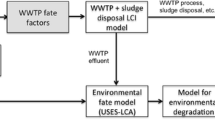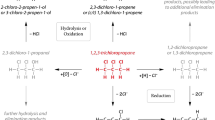Abstract
Purpose
As knowledge grows of the potentially harmful effects of chemicals in widespread use, emerging contaminants have become a major source of concern and uncertainty for public health officials and water quality managers. Perfluorinated alkyl substances, often referred to as perfluorinated compounds, have come under recent scrutiny and are present in groundwater at many sites across the USA. We examine the life cycle impacts of treating drinking water at one such site.
Methods
We assembled life cycle models for groundwater treatment and bottled water delivery to residents of Wright-Patterson Air Force Base, Ohio, where wells were recently taken out of service due to concerns related to perfluoroalkyl and polyfluoroalkyl substance (PFAS) contamination. Two treatment methods, granular activated carbon filtration and ion-exchange columns, were modeled under a range of contaminant concentrations covering three orders of magnitude: 0.7, 7.0, and 70 μg/L PFAS. On-site infrastructure, operations, and adsorbent cycling were included in models. Impacts of bottled water production and supply were assessed using two data sets reflecting a range of production and supply chain assumptions. Uncertainty in input data was captured using Monte Carlo simulations.
Results and discussion
Results show that for contaminant concentrations below 70 μg/L, the dominant contributor to life cycle impacts is electricity use at the treatment facility. Production, reactivation, and disposal of treatment media become major sources of impact only at very high PFAS concentrations. Though the life cycle impacts of bottled water are up to three orders of magnitude higher than remediated groundwater on a volumetric basis, supplementing a contaminated water supply with bottled drinking water may result in lower life cycle human health impacts when only a small proportion of the total population is vulnerable.
Conclusions
These results provide quantitative data and proposed scenarios for water quality managers and risk management officials in developing plans to address PFAS contamination and emerging contaminants in general. However, more information on the direct human health effects of these poorly understood pollutants is needed before the trade-offs in life cycle health impacts can be comprehensively assessed.





Similar content being viewed by others
References
Amec Foster Wheeler (2017) Perfluorinated compounds release response at multiple BRAC bases: site 8 pilot test results report. Former Pease Air Force Base, Lackland
Anderson RH, Long GC, Porter RC, Anderson JK (2016) Occurrence of select perfluoroalkyl substances at U.S. air Force aqueous film-forming foam release sites other than fire-training areas: field-validation of critical fate and transport properties. Chemosphere 150:678–685
Appleman TD, Dickenson ERV, Bellona C, Higgins CP (2013) Nanofiltration and granular activated carbon treatment of perfluoroalkyl acids. J Hazard Mater 260:740–746
Appleman TD, Higgins CP, Quiñones O, Vanderford BJ, Kolstad C, Zeigler-Holady JC, Dickenson ERV (2014) Treatment of poly- and perfluoroalkyl substances in U.S. full-scale water treatment systems. Water Res 51:246–255
Asdrubali F, Baldinelli G, D’Alessandro F, Scrucca F (2015) Life cycle assessment of electricity production from renewable energies: review and results harmonization. Renew Sust Energ Rev 42:1113–1122
Barzen-Hanson KA, Roberts SC, Choyke SJ, Oetjen K, McAlees A, Riddell N, McCrindle R, Ferguson PL, Higgins CP, Field JA (2017) Discovery of 40 classes of per- and polyfluoroalkyl substances in historical aqueous film-forming foams (AFFFs) and AFFF-impacted groundwater. Environ Sci Technol 41:2047–2057
Bayer P, Finkel M (2006) Life cycle assessment of active and passive groundwater remediation technologies. J Contam Hydrol 83:171–199
CDPH (Colorado department of public health) (2016) PFC Levels in Environmental Water Samples Collected from the Widefield Aquifer Region. https://www.colorado.gov/pacific/sites/default/files/WQ_PFC_Environmental-data-table.pdf
Ciroth A, Muller S, Weidema BP, Lesage P (2012) Refining the pedigree matrix approach in ecoinvent : Towards empirical uncertainty factors. LCA Discussion Forum
Dickenson E, Higgins C (2016) Treatment mitigation strategies for poly- and perfluorinated chemicals (pp 1–123). Retrieved from http://www.waterrf.org/PublicReportLibrary/4322.pdf. Accessed 25 Jan 2018
Fantin V, Scalbi S, Ottaviano G, Masoni P (2014) A method for improving reliability and relevance of LCA reviews: the case of life-cycle greenhouse gas emissions of tap and bottled water. Sci Total Environ 476–477:228–241
Filipovic M, Woldegiorgis A, Norström K, Bibi M, Lindberg M, Österås A-H (2015) Historical usage of aqueous film forming foam: a case study of the widespread distribution of perfluoroalkyl acids from a military airport to groundwater, lakes, soils and fish. Chemosphere 129:39–45
Finkbeiner M, Inaba A, Tan RBH, Christiansen K, Klüppel HJ (2006) The new international standards for life cycle assessment: ISO 14040 and ISO 14044. Int J Life Cycle Assess 11:80–85
Garfí M, Cadena E, Sanchez-Ramos D, Ferrer I (2016) Life cycle assessment of drinking water: comparing conventional water treatment, reverse osmosis and mineral water in glass and plastic bottles. J Clean Prod 137:997–1003
Gleick PH, Cooley HS (2009) Energy implications of bottled water. Environ Res Lett 4:14009. https://doi.org/10.1088/1748-9326/4/1/014009
Grandjean P, Clapp R (2015) Perfluorinated alkyl substances: emerging insights into health risks. New Solut 25:147–163
Hale SE, Arp HPH, Slinde GA, Wade EJ, Bjørseth K, Breedveld GD, Straith BF, Moe KG, Jartun M, Høisæter Å (2017) Sorbent amendment as a remediation strategy to reduce PFAS mobility and leaching in a contaminated sandy soil from a Norwegian firefighting training facility. Chemosphere 171:9–18
Hauschild MZ, Goedkoop M, Guinee J, Heijungs R, Huijbregts M, Jolliet O, Margni M, de Schryver A, Humbert S, Laurent A, Sala S, Pant R (2013) Identifying best existing practice for characterization modeling in life cycle impacts assessment. Int J Life Cycle Assess 18:683–697
Hertwich EG, Gibon T, Bouman EA, Arvesen A, Suh S, Heath GA, Bergesen JD, Ramirez A, Vega MI, Shi L (2014) Integrated life-cycle assessment of electricity-supply scenarios confirms global environmental benefit of low-carbon technologies. Proc Natl Acad Sci U S A 112:6277–6282
Huijbregts MAJ, Rombouts LJA, Ragas AMJ, van de Meent D (2005) Human-toxicological effect and damage factors of carcinogenic and noncarcinogenic Chemicals for Life Cycle Impact Assessment Human-Toxicological Effect and Damage Factors of carcinogenic and noncarcinogenic Chemicals for Life Cycle Impact Assessment. Integr Environ Assess Manag 1:181–244
Huset CA, Chiaia AC, Barofsky DF, Jonkers N, Kohler HPE, Ort C, Giger W, Field JA (2008) Occurrence and mass flows of fluorochemicals in the Glatt Valley watershed, Switzerland. Environ Sci Technol 42:6369–6377
Hutchinson RA (1975) Thermal regeneration costs. Chem Eng Prog 71:86–88
Isla-cabaraban MT, Marc G, Cabaraban S (2016) Generating electricity from spent activated carbon : life cycle environmental benefits. WSEAS Trans Environ Dev 12:1–8
Jeswani HK, Gujba H, Brown NW, Roberts EPL, Azapagic A (2015) Removal of organic compounds from water: life cycle environmental impacts and economic costs of the Arvia process compared to granulated activated carbon. J Clean Prod 89:203–213
Krishnan N, Boyd S, Somani A, Raoux S, Clark D, Dornfeld D (2008) A hybrid life cycle inventory of nano-scale semiconductor manufacturing. Environ Sci Technol 42:3069–3075
Lang JR, Allred BM, Field JA, Levis JW, Barlaz MA (2017) National Estimate of per- and Polyfluoroalkyl substance (PFAS) release to U.S. municipal landfill leachate. Environ Sci Technol 51:2197–2205
Lloyd-Smith M, Senjen R (2015) The persistence and toxicity of perfluorinated compounds in Australia, (November), 1–13. Retrieved from http://www.ntn.org.au/wp/wp-content/uploads/2016/11/NTNPerfluoros-in-Australia-NOV-2016.pdf. Accessed 25 Jan 2018
Martin RJ, Ng WJ (1991) The Thermal Regeneration of Exhausted Activated Carbon: The Balance Between Weight Loss and Regeneration Efficiency. In: Pawlowski L, Lacy WJ, Dlugosz JJ (eds) Chemistry for the Protection of the Environment. Environmental Science Research, vol 42. Springer, Boston
Merino N, Qu Y, Deeb RA, Hawley EL, Hoffmann MR, Mahendra S (2016) Degradation and removal methods for Perfluoroalkyl and Polyfluoroalkyl substances in water. Environ Eng Sci 33:615–649. https://doi.org/10.1089/ees.2016.0233
Moody CA, Field JA (2000) Perfluorinated surfactants and the environmental implications of their use in fire-fighting foams. Environ Sci Technol 34:3864–3870
Pistocchi A, Loos R (2009) A map of European emissions and concentrations of PFOS and PFOA. Environ Sci Technol 43:9237–9244
Place BJ, Field JA (2012) Identification of novel Fluorochemicals in aqueous film- forming foams (AFFF) used by the US military. Environ Sci Technol 46:7120–7127
Quantis (2010) Nestlé waters North America: environmental life cycle assessment of drinking water alternatives and consumer beverage consumption in North America. Quantis Sustainability counts, Salem, MA. https://www.nestlewatersna.com/asset-library/documents/nwna_lca_report_020410.pdf. Accessed 25 Jan 2018
Rahman MF, Peldszus S, Anderson WB (2014) Behaviour and fate of perfluoroalkyl and polyfluoroalkyl substances (PFASs) in drinking water treatment: a review. Water Res 50:318–340
Schaider LA, Balan SA, Blum A, Andrews DQ, Strynar MJ, Dickinson ME, Lunderberg DM, Lang JR, Peaslee GF (2017) Fluorinated compounds in U.S. fast food packaging. Environ Sci Technol Lett 4:105–111
USCDC (2016) Deaths and Mortality [WWW Document]. FastStats. URL https://www.cdc.gov/nchs/fastats/deaths.htm. Accessed 3.10.17
USEPA (2011) Planning for an emergency drinking water supply (June), 1–40. https://www.epa.gov/sites/production/files/2015-03/documents/planning_for_an_emergency_drinking_water_supply.pdf. Accessed 25 Jan 2018
USEPA (2016a) Health effects support document for perfluorooctanoic acid (PFOA), (822-R-16–003). https://www.epa.gov/sites/production/files/2016-05/documents/pfoa_hesd_final-plain.pdf. Accessed 25 Jan 2018
USEPA (2016b) Drinking water health advisory for perfluorooctanoic acid (PFOA), (May), 1–103. https://www.epa.gov/sites/production/files/2016-05/documents/pfoa_health_advisory_final-plain.pdf. Accessed 25 Jan 2018
USEPA (2016c) Drinking water health advisory for perfluorooctane sulfonate (PFOS), (May), 1–103. https://www.epa.gov/sites/production/files/2016-05/documents/pfos_health_advisory_final-plain.pdf. Accessed 25 Jan 2018
USEPA (2016d) Valuing mortality risk reductions for policy: a meta-analytic approach (pp. 1–77). https://yosemite.epa.gov/sab/sabproduct.nsf/0/0CA9E925C9A702F285257F380050C842/$File/VSL%20white%20paper_final_020516.pdf. Accessed 25 Jan 2018
USEPA (2017) Inventory of U.S. greenhouse gas emissions and sinks: 1990–2015, chapter 4: Industrial Processes and Product Use, Washington, DC. https://www.epa.gov/sites/production/files/2017-02/documents/2017_complete_report.pdf. Accessed 25 Jan 2018
Acknowledgements
The authors thank Treva Bashore and Michael Brady with the Air Force Civil Engineering Center for their helpful conversations in identifying case studies for this project. We are also grateful to Ryan Morrish with Bay West, LLC., Kendra Ryan with Calgon Carbon, Inc., William Scoville from CBI Federal Services, Inc., Steve Woodard with Emerging Contaminant Treatment Technologies, and Brandon Newman with Amec Foster Wheeler, Inc. for supplying data. This research was supported by Defense Environmental Restoration Account (DERA) funds, and by an appointment to the Postgraduate Research Participation Program at the U.S. Air Force Institute of Technology (AFIT) administered by the Oak Ridge Institute for Science and Education through an interagency agreement between the US Department of Energy and AFIT. The views expressed in this paper are those of the authors and do not reflect the official policy or position of the US Air Force, the US Department of Defense, or the US government.
Author information
Authors and Affiliations
Corresponding author
Additional information
Responsible editor: Chris Yuan
Electronic supplementary material
ESM 1
(DOCX 73 kb)
Rights and permissions
About this article
Cite this article
Emery, I., Kempisty, D., Fain, B. et al. Evaluation of treatment options for well water contaminated with perfluorinated alkyl substances using life cycle assessment. Int J Life Cycle Assess 24, 117–128 (2019). https://doi.org/10.1007/s11367-018-1499-8
Received:
Accepted:
Published:
Issue Date:
DOI: https://doi.org/10.1007/s11367-018-1499-8




